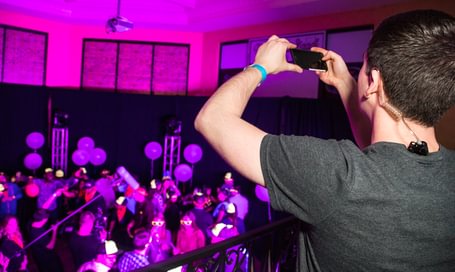Humor and Humanity: Using Comedy in Your Writing

Writing Comedy Well
Avoid Puns
Puns rely on the similarity of sound or meaning of two words or phrases. They can be clever, but they can also be overused, predictable, and groan-inducing. Puns can also alienate your audience if they don’t understand the reference or the language.
Instead of puns, try using more original and creative humor, such as irony, sarcasm, satire, parody, or absurdity.
However, puns are great if you’re telling dad jokes… which we do have a Slack channel for (it’s true).
Use the Rule of Three
The Rule of Three (or Comic Triple) is a classic comedy technique that involves setting up a pattern with two items and then breaking it with a third, unexpected item. The contrast between the first two items and the third creates a surprise and a laugh.
The Rule of Three can also create a climax or a resolution in a story by having the third item be the most important or the most satisfying.
Lastly, a Rule or Two isn’t as exciting. We needed a third item to hammer this home. This was an example of the Rule of Three. It wasn’t as funny as we’d hoped.
Write TV-safe Comedy
TV-safe comedy is suitable for a general audience without being too offensive, controversial, or vulgar making it an appropriate option for commercials, sitcoms, or sketch shows, where the goal is to entertain and appeal to a wide range of viewers.
The writing is usually witty, clever, and light-hearted rather than confrontational, aggressive, or dark, and avoids controversy, profanity, insults, and stereotypes.
Instead, you can focus on relatable, universal, and humorous topics, like family, work, relationships, hobbies, or everyday situations.
Don’t worry. TV-funny can still lead to laughs.
Find the Unexpected
One of the keys to comedy is to find the unexpected moments in your story where you can surprise your audience with a twist, a reveal, or a joke.
Unexpected moments can be created using contrast, incongruity, exaggeration, or reversal. Finding the unexpected moments can make your story more engaging, unpredictable, and funny.
Care Bears, the 1990s toy phenomenon, are unexpected in this sentence. Now, you probably didn’t laugh at that, but you probably didn’t expect it either.
Inside Jokes
The people around you might all laugh at things you all mutually understand. Inside jokes aren’t great comedy for your scripts. However, real-life scenarios and inside jokes can inform great ideas. So don’t throw them away, but don’t rely on them.
It’s like that time Mike told Barbara’s aunt Becky that thing about the big party. Don’t worry about it. You had to be there. You wouldn’t have liked it anyway. You would have loved it!
Writing Comedy for Brands
Writing comedy is both an art and a science. When properly executed, humor can enhance a brand's image, making it memorable and engaging.
When it misses the mark, it really misses the mark, so it’s crucial to look at your writing from a holistic perspective using some of the guidelines that follow.
Understand the Brand and Audience: Before any jokes fly, get a solid grasp on the brand's identity, values, and target audience. What resonates with them? What are their preferences and pain points?
Establish the Objective: Is the goal to introduce a new product, increase brand awareness, or perhaps address a misconception? Pinpointing the purpose will guide the comedic narrative.
Brainstorm Ideas: Gather a diverse group to brainstorm comedic angles. The more diverse the group, the broader the range of comedic ideas you can explore. Encourage wild and outrageous ideas — sometimes they can be refined into comedic gold.
Choose the Right Type of Humor: From slapstick and satire to wordplay and observational humor, there's a myriad of comedic styles. Choose one that aligns with the brand's personality and appeals to the target audience.
Create a Relatable Scenario: Root the humor in real-life situations or common perceptions that the audience can identify with. This not only amplifies the comedic effect but also ensures relevance.
Keep it Simple: A complicated setup can dilute the punchline. Ensure the scenario is easily understood and gets to the comedic point swiftly.
Ensure Brand Integration: The brand or product should be seamlessly integrated into the narrative. The comedy should feel like a natural extension of the brand's message, not a forced addition.
Avoid Controversy: Be culturally sensitive and steer clear of topics that could offend or alienate segments of your audience. What's funny to one person might be offensive to another.
Test and Refine: Before finalizing, test the script on a small focus group representing your target audience. Collect feedback and refine the script accordingly.
Production Quality Matters: Even if your script is hilarious, poor execution can ruin its impact. Invest in good production values, whether a well-timed sound effect, the perfect actor, or high-quality animation.
When in doubt, deploy a professional or revert to authenticity.
If you’re ready to find the unexpected and create something beautiful, get in touch with us.

